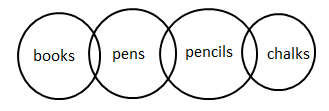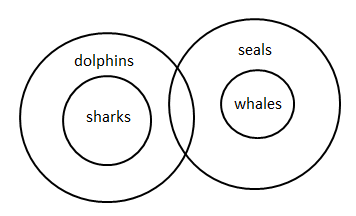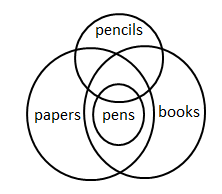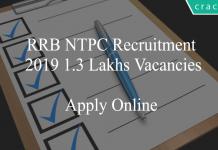RRB JE Syllogism Questions PDF
Download RRB JE Syllogism Questions and Answers PDF. Top 25 RRB JE Maths questions based on asked questions in previous exam papers very important for the Railway JE exam
Download RRB JE Syllogisms Questions PDF
Download RRB JE Previous Papers PDF
Instructions
In the following question three statements are given, followed by two conclusions. You have to consider the statements to be true even if they seem to be at variance from commonly known facts. You have to decide which of the given conclusions, if any, follows from the given statements and select the appropriate option.
Question 1: Statement I: All pages are books
Statement II: No book is a register
Statement III: Some registers are notebooks
Conclusion I: Some books can be notebooks
Conclusion II: All pages can be notebooks
a) Conclusion I only
b) Conclusion II only
c) Both the conclusions follow
d) Either conclusion I or conclusion II follows
Question 2: Statement I: All tables are desks
Statement II: All chairs are class
Statement III: No table is a chair
Conclusion I: No desk can be chair
Conclusion II: No class can be table
a) Conclusion I only
b) Conclusion II only
c) None of the conclusions follows
d) Either conclusion I or conclusion II follows
Instructions
In these questions, the relationship between different elements is shown in the statements. These statements are followed by two conclusions. Study the conclusions based on the given statement(s) and select the appropriate answer.
Question 3: No tree is a herb.
Some shrubs are grass.
No grass is a herb.
Conclusions:
I: No shrub can be a herb
II: No grass can be a tree
a) Only conclusion I follows
b) Only conclusion II follows
c) Either conclusion I or II follows
d) Neither of the conclusions follow
RRB JE Free Mock Test (latest pattern)
Instructions
In the following question three statements are given, followed by two conclusions. You have to consider the statements to be true even if they seem to be at variance from commonly known facts. You have to decide which of the given conclusions, if any, follows from the given statements and select the appropriate option.
Question 4: Statement I: Some TVs are radios.
Statement II: No radio is an AC.
Statement III: All ACs are heaters.
Conclusion I: Some TVs can be ACs.
Conclusion II: Some heaters can be radios.
a) Conclusion I only
b) Conclusion II only
c) Both the conclusions follow
d) Either conclusion I or conclusion II follows
Question 5: In this question three statements are given, followed by two conclusions. You have to consider the statements to be true even if they seem to be at variance from commonly known facts. You have to decide which of the given conclusions, if any, follows from the given statements and select the appropriate option.
Statement I: Some books are pens.
Statement II: Some pens are pencils.
Statement III: No pen is a chalk.
Conclusion I: Some pencils can be chalks.
Conclusion II: All books can be chalks.
a) Conclusion I follows
b) Conclusion II follows
c) Both conclusion I and conclusion II follow
d) Neither conclusion I nor conclusion II follow
Question 6: In the question three statements are given, followed by two conclusions, I and II. You have to consider the statements to be true even if it seems to be at variance from commonly known facts. You have to decide which of the given conclusions, if any, follows from the given statements.
Statement I: All sharks are dolphins.
Statement II: No dolphin is a whale.
Statement III: All whales are seals.
Conclusion I: Some sharks are whales.
Conclusion II: Some dolphins can be seals.
a) Only conclusion I follows.
b) Only conclusion II follows.
c) Both conclusion I and II follow
d) Neither conclusion I nor II follow
18000+ Questions – Free SSC Study Material
Question 7: In the question three statements are given, followed by two conclusions, I and II. You have to consider the statements to be true even if it seems to be at variance from commonly known facts. You have to decide which of the given conclusions, if any, follows from the given statements.
Statement I: Some papers are books.
Statement II: Some books are pens.
Statement III: Some pens are pencils.
Conclusion I: All pens can be papers.
Conclusion II: No pencil is a book.
a) Conclusion I follows only
b) Conclusion II follows only
c) Both conclusion I and conclusion II follow
d) Neither conclusion I nor conclusion II follows
Question 8: In the question two statements are given, followed by two conclusions, I and II. You have to consider the statements to be true even if it seems to be at variance from commonly known facts. You have to decide which of the given conclusions, if any, follows from the given statements.
Statement I: Some cars are bikes
Statement II: All bikes are buses
Conclusion I: Some buses are cars
Conclusion II: No car is a bus
a) Only conclusion I follows
b) Both conclusions I and II follow
c) Neither conclusion I nor conclusion II follows
d) Either conclusion I or conclusion II follows
Question 9: In the question two statements are given, followed by two conclusions, I and II. You have to consider the statements to be true even if it seems to be at variance from commonly known facts. You have to decide which of the given conclusions, if any, follows from the given statements.
Statement 1:Some Trees are Green
Statement 2:No green is Yellow
Statement 3:Some Yellow are Plants
Conclusion I:Some Trees are plants is a possibility
Conclusion II:Some Plants are not Green
a) Only Conclusion II follows
b) Both Conclusion I and Conclusion II follows
c) Either Conclusion I or Conclusion II follows
d) Only Conclusion I follows
Question 10: In the following question, two statements are given each followed by two conclusions I and II. You have to consider the statements to be true even if they seem to be at variance from commonly known facts. You have to decide which of the given conclusions, if any, follows from the given statements.
Statements:
(I) Some polynomials are linear equations.
(II) Some linear equations are quadratic.
Conclusion:
(I) Polynomials are quadratic.
(II) Linear equations are quadratic.
a) Conclusion I follows
b) Conclusion II follows
c) Neither I nor II follows
d) Both I and II follows
Question 11: Statements:
I. All flowers are bottles.
II. Some bottles are chairs.
Conclusion:
I. No flowers are chairs.
II. Some flowers being chairs is a possibility.
a) If only conclusion I follows.
b) If only conclusion II follows.
c) If both conclusion I and conclusion II follow.
d) If neither conclusion I nor conclusion II follows.
Question 12: Based on the statements given, select the conclusions that definitely follow:
Statements:
No actor is a producer.
Some directors are producers.
Conclusion I: Some directors are not actors.
Conclusion II: No director is an actor.
a) Only conclusion I follows.
b) Only conclusion II follows.
c) Both conclusions I and II follow.
d) Neither of the conclusions follow.
Question 13: In each of the questions given below, there are two statements which are followed by 2 conclusions. You have to take the given statements to be true even if they seem to be at variance from the commonly known facts. You have to then decide which of the given conclusions logically follow from the given statements.
Statements:
I. All squares are hits
II. All hits are triangles
Conclusions:
I. All triangles are squares
II. Some squares are hits but not triangles
a) Only conclusion I follows
b) Only conclusion II follows
c) Neither conclusion I nor II follow
d) Both the conclusions follow
Instructions
In the next 5 questions, statements are provided followed by 2 conclusions. Which of the conclusions are implied from the statements.
Question 14: Some cats are red. No red is a doodle.
Conclusion 1) Some cats are doodles. 2) No doodle is red.
a) Only conclusion 1 is implied.
b) Only conclusion 2 is implied.
c) Either of the conclusions is implied.
d) Neither of the conclusions is implied.
Daily Free Online Tests for RRB Exams
Question 15: All lovers are stresses. All Stresses are truths.
Conclusions 1) Some truths are lovers 2) All lovers are truths.
a) Only conclusion 1 is implied.
b) Only conclusion 2 is implied.
c) Both the conclusions are implied.
d) Neither of the conclusions is implied.
Question 16: Some rags are riches. Some riches are chains.
Conclusions 1) Some chains are rags. 2) No chain is a rag.
a) Only conclusion 1 is implied.
b) Only conclusion 2 is implied.
c) Either of the conclusions is implied.
d) Neither of the conclusions is implied.
Instructions
In the following questions, some statements are provided followed by 2 conclusions. Which of the conclusions are implied from the statements?
Question 17: All levers are truths. No truth is a treat. All treats are brushes.
Conclusions 1) No lever is a treat. 2) Some brushes are levers.
a) Only conclusion 1 implies
b) Only conclusion 2 implies
c) Either of the conclusions imply
d) Neither of the conclusions imply
Question 18: Some pains are nil. All nil are humans. All humans are doodles.
Conclusion 1) All doodles are pains. 2) All nil are doodles.
a) Only conclusion 1 implies
b) Only conclusion 2 implies
c) Either of the conclusions imply
d) Neither of the conclusions imply
Question 19: All droughts are knights. All evergreens are knights. All knights are moaning.
Conclusion 1) All droughts are moanings. 2) Some moanings are evergreen.
a) Only conclusion 1 implies
b) Only conclusion 2 implies
c) Either of the conclusions imply
d) Both the conclusions imply.
Question 20: Some strains are rickets. Some rickets are destiny. Some destiny are Godgiven.
Conclusions 1) Some Godgivens are strains. All destiny are strains.
a) Only conclusion 1 implies
b) Only conclusion 2 implies
c) Either of the conclusions imply
d) Neither of the conclusions imply
General Science Notes for RRB Exams (PDF)
Answers & Solutions:
1) Answer (C)

From the diagram, we can see that All pages can be notebooks and some books can be notebooks.
Hence, option C is the correct answer.
2) Answer (C)

From the diagram, we can see that some desks can be chair and some class can be table.
Hence, option E is the correct answer.
3) Answer (D)
The given statements can be expressed diagrammatically as follows without violating any condition.

As we can see, neither of the conclusions follow. Therefore, option D is the right answer.
4) Answer (C)

From the diagram, we can see that some TVs can be ACs. Hence, conclusion I follows.
From the diagram, we can see that some heaters can be radios. Hence, conclusion II follows.
Therefore, option C is the correct answer.
5) Answer (A)

From the venn diagram, we can see that conclusion I follows.
Some books are pens and no pen is a chalk. So, some books are definitely not chalks. Thus, all books cannot be chalks. So, conclusion II is not possible. Hence, option A is the correct answer.
6) Answer (B)
The below Venn diagram shows a possibility.
From the venn diagram we can see that only conclusion II follows.

7) Answer (A)

From the venn diagram we can see that only conclusion I follows.
8) Answer (A)

From the venn diagram we see that only conclusion I follows.
9) Answer (B)


Some Plants are not green as all yellow are not Green. And as we can see some Trees are Plants is a possibility. Hence, option B is correct.
10) Answer (C)
The venn diagram for above statements is :

Conclusion:
(I) Polynomials are quadratic = false
(II) Linear equations are quadratic = false
Thus, neither I nor II follows
=> Ans – (C)
11) Answer (B)
Based on the statements given we can make following possibilities –

We cannot definitely say that conclusion I follow as other possibilities exist.
Conclusion II follows.
Hence, option B is right choice.
12) Answer (A)
No actor is a producer. Some directors are producers.
The following diagram represents a possibility.

Directors, who are producers, cannot be actors. Therefore, some directors are not actors. Hence, conclusion I is definitely true.
Directors, who are not producers, can be actors. Therefore, we cannot say conclusion II to be definitely true. Therefore, only conclusion I follows. Hence, option A is the right answer.
13) Answer (C)
We have following possibility as shown in the diagram:

Thus neither I nor II follows.
Hence, option C is the right answer.
14) Answer (B)

The Venn diagram for the concerned syllogism is as follows. That explains the answer
15) Answer (C)

The Venn diagram for the concerned syllogism is as follows. That explains the answer
16) Answer (C)

The Venn diagram for the concerned syllogism is as follows. That explains the answer. Since the conclusions are complimentary, either of them is implied.
17) Answer (A)

The Venn Diagram for the concerned statements is as follows. So, only conclusion 1 is implied.
18) Answer (B)

The Venn Diagram for the concerned statements is as follows. So, only conclusion 2 is implied.
19) Answer (D)

The Venn Diagram for the concerned statements is as follows. So, both the conclusions are implied.
20) Answer (D)

The Venn Diagram for the concerned statements is as follows. So, neither of the conclusions are implied.
DOWNLOAD APP FOR RRB FREE MOCKS
We hope this Syllogism Questions for RRB JE Exam will be highly useful for your preparation.





